
 I wonder what Fedex would charge for that?
I wonder what Fedex would charge for that?
No shoes, no shirt, no problem.
Make sure you know this procedure inside and out before shipping out into a Maritime case.An Admiralty Proceeding might go something like this (the Boatswain has already wrung three bells):
Judge: Gentlemen; is there any further evidentiary issue to report before we raise the topsail and get underway**?
Counsel A: Ahoy! Permission to come aboard, Cap'n.
Judge: Permission granted............Call your next hand***.
Counsel A: Aye, Cap'n. I'd be a-calling Ben Gunn...
Counsel B: Arghhh, Cap'n. I be objectin'. That blasted Scurvy Knave never named no Ben Gunn as a hand. Aye, and the crew**** may be prejudiced by me lack of abilities to question the lad, lest I be havin' a moment or two for preparation, and such.
Counsel A: Shiver me timbers, Cap'n. There be no prejudice if I be calling Ben Gunn. A better crewman has never sailed these seas.....Judge: Gentlemen, gentlemen. This ship cannot long last the tempests of litigation with such conflict. Now; Mr. Gunn is a fine lad, and his integrity is not in question here. But the crew cannot be expected to properly perform its duty if Counsel has not had the opportunity to prepare.
Counsel A: Ahoy, Cap'n. But might the crew be due for a day in port*****? And might the time the crew be spending in quarters****** give the Scurvy Knave his precious time for preparation?
Counsel B: Arghhh! I be objectin' to that too, Cap'n. Why, I've sailed the seven seas but never with a scurvier knave than this here bloke*******, and . . .
Judge: Counsel B, your objection is noted and shall be recorded in the log book********. Boatswain, dismiss the crew to quarters with an extra ration of rum. Counsel B, you now have your opportunity. I suggest you use it wisely.
Counsel B: Aye, Cap'n. But we'll be havin' a mutiny********* on this point, Cap'n; mark my words.
 My trailer is not as wide and does not have a rectangular shape, so I am modifying the design on the fly. Based on a suggestion from Tillerman, one side of the box is on a hinge so I will be able to get gear out of the box without taking the boat off the trailer.
My trailer is not as wide and does not have a rectangular shape, so I am modifying the design on the fly. Based on a suggestion from Tillerman, one side of the box is on a hinge so I will be able to get gear out of the box without taking the boat off the trailer.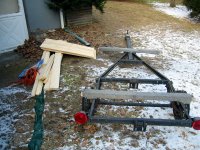
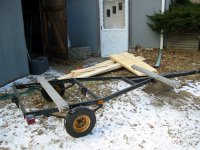 I bought three 8' 2x6, four 2'x4' plywood panels and some other assorted wood.
I bought three 8' 2x6, four 2'x4' plywood panels and some other assorted wood.

 It started to get dark before I could start trimming the plywood so the rest of the project will have to wait for another day.
It started to get dark before I could start trimming the plywood so the rest of the project will have to wait for another day.


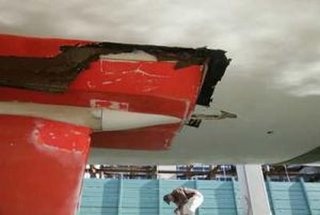
The boat was taken to a boat lift and immediately the hull cleared the water it was obvious that large parts of the keel wedges that fair the keel aperture and the sliding “bomb doors” had been ripped from the hull. There was also damage to the fairing at the hull aperture for the port side dagger board.
Now that the boat has accepted the 2 hour penalty for the next leg they can have their shore team or outside experts to work on the boat until it is time to leave for the start of Leg 4.
The wedges are foam and carbon fibre fillers between the sliding plates that move with the canting keel to stop most of the water that might come into the boat through the hole the keel works through.
The whole repair was done while the boat was hanging from the hoist.

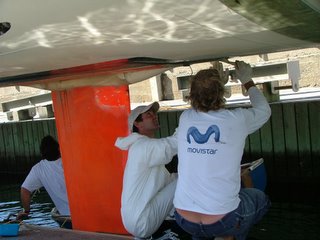
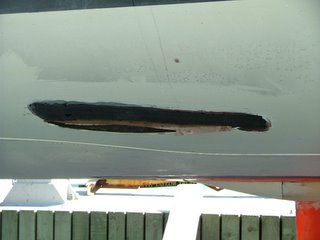
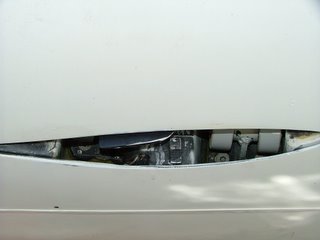
 BEIJING (Reuters) - A lucky bidder may come away from an auction in China with their very own Russian aircraft carrier -- albeit one converted into a floating theme park with a movie theatre and restaurants.
BEIJING (Reuters) - A lucky bidder may come away from an auction in China with their very own Russian aircraft carrier -- albeit one converted into a floating theme park with a movie theatre and restaurants. Bidding is expected to start at a cool 128 million yuan (9 million pounds), Chinese media said on Friday.
The Minsk, a decades-old, decommissioned relic of the Soviet era, was first bought by a Chinese company for scrap metal in 1998 but then sold to an entertainment firm, which poured millions of dollars into turning the ship into a tourist attraction.
The carrier opened to the public in the southern boomtown of Shenzhen in September 2000 as the main draw of the military-themed Minsk Aircraft Carrier World amusement park.
A Chinese travel agency describes the theme park as "a harmonious combination of carrier appreciation, military recreation, typical seaside lifestyle in south China and military atmosphere".
The ship's attractions included torpedoes and a Russian dance troupe that performed folk dances, the agency says.
But the company that operated the park, Minsk World Industries Co. Ltd., sank deep into the red and was declared bankrupt by a Shenzhen court in March last year, the Beijing News reported.
The court commissioned a southern China-based auction firm to handle the March 22 sale of the ship, which the auction company confirmed on Thursday, it said.
Despite the company's collapse, the theme park had stayed in business and drew 33,000 visitors during the recent Lunar New Year holiday, the Shanghai Daily reported.
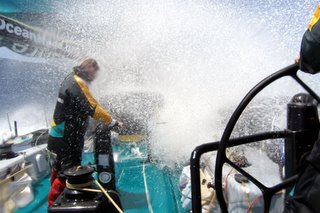 Gerd Jan Poortman was badly injured when he was swept from the bow all the way to the back of the boat by a huge wave that also damaged the bow pulpit.
Gerd Jan Poortman was badly injured when he was swept from the bow all the way to the back of the boat by a huge wave that also damaged the bow pulpit.

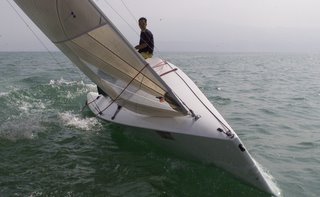

 Unfortunately, in June of 2003 one of his former employees sold the JS 9000 molds to Boldgold Investments who started the process of manufacturing a copy of Swarbrick's JS 9000.
Unfortunately, in June of 2003 one of his former employees sold the JS 9000 molds to Boldgold Investments who started the process of manufacturing a copy of Swarbrick's JS 9000. In a decision delivered in June 2004 (Swarbrick v Burge (2004) 208 ALR 19; [2004] FCA 813), the Federal Court of Australia ruled that the yacht was protected as both a sculpture and a work of artistic craftsmanship under the Copyright Act. Furthermore, the Court found that copyright also existed in various items used in the making of the JS 9000, in addition to the yacht itself. These items included a number of drawings and molds, as well as the "plug" - a wooden handcrafted full-size model of the hull and deck of the boat which is then used to create the mould. The court compared the boat-building process to "the modus operandi of Auguste Rodin", finding that the yacht, plug and mould had real aesthetic quality in addition to their functionality and noted that "the antithesis between function and beauty is a false one". In other words, they were not only artistic works, but works of artistic craftsmanship and had therefore not lost copyright protection by reason of industrial application.
In a decision delivered in June 2004 (Swarbrick v Burge (2004) 208 ALR 19; [2004] FCA 813), the Federal Court of Australia ruled that the yacht was protected as both a sculpture and a work of artistic craftsmanship under the Copyright Act. Furthermore, the Court found that copyright also existed in various items used in the making of the JS 9000, in addition to the yacht itself. These items included a number of drawings and molds, as well as the "plug" - a wooden handcrafted full-size model of the hull and deck of the boat which is then used to create the mould. The court compared the boat-building process to "the modus operandi of Auguste Rodin", finding that the yacht, plug and mould had real aesthetic quality in addition to their functionality and noted that "the antithesis between function and beauty is a false one". In other words, they were not only artistic works, but works of artistic craftsmanship and had therefore not lost copyright protection by reason of industrial application.

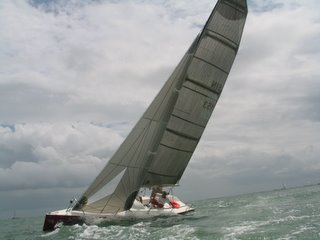



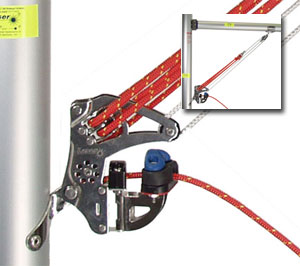 And Holt Allen's version:
And Holt Allen's version: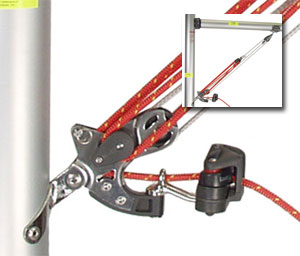
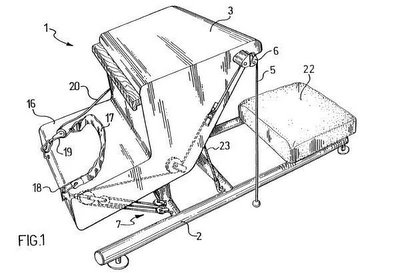 The PCT application has been designated for regional patents in a bunch of countries, notably the US, New Zealand, Australia and the UK. It has only issued as an actual patent in Australia but it has entered the examination process in the US. Here's an excerpt from the description of the invention:
The PCT application has been designated for regional patents in a bunch of countries, notably the US, New Zealand, Australia and the UK. It has only issued as an actual patent in Australia but it has entered the examination process in the US. Here's an excerpt from the description of the invention: There's no way that I am going to build anything like that.
There's no way that I am going to build anything like that.
 When I was working at the St. Croix Yacht Club as a sailing instructor I met Chris, Scott and Peter Stanton who were local kids with some great sailing talent. Their family was originally from the Jersey shore and the boys regularly cleaned up on the Caribbean J24 circuit in their boat Jersey Devil. While I was teaching at the yacht club, Scott and Peter had managed to find an old 470 that was so soft that you could watch it flex over every wave. The boys were only about 14 years old, but they were incredible sailors. I remember that the boys travelled to regattas in Miami and did acceptably well considering the condition of their boat. Scott Stanton now sails for Texas A&M and Peter sails for Eckerd College. Peter was third (with older brother Chris Stanton as crew) in the 470 at the 1999 Miami OCR and is registered for the 2006 Miami OCR. If I have time I'll follow his results in Miami and post them here.
When I was working at the St. Croix Yacht Club as a sailing instructor I met Chris, Scott and Peter Stanton who were local kids with some great sailing talent. Their family was originally from the Jersey shore and the boys regularly cleaned up on the Caribbean J24 circuit in their boat Jersey Devil. While I was teaching at the yacht club, Scott and Peter had managed to find an old 470 that was so soft that you could watch it flex over every wave. The boys were only about 14 years old, but they were incredible sailors. I remember that the boys travelled to regattas in Miami and did acceptably well considering the condition of their boat. Scott Stanton now sails for Texas A&M and Peter sails for Eckerd College. Peter was third (with older brother Chris Stanton as crew) in the 470 at the 1999 Miami OCR and is registered for the 2006 Miami OCR. If I have time I'll follow his results in Miami and post them here.


